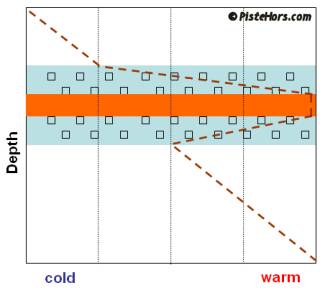I was out this morning in the Chartreuse. Around 1650 meters I skinned over a small shrub, but it could just have easily been a rock and I took this photo which illustrates a point quite well
You can see from the ski pole, which was down as far a solid snow base, that there is around 40cm of snow depth on the slope. However above the shrub there is just 20cm. The air temperature was around -4C at the time. So the general temperature gradient (TG) from ground to surface is around 10C/meter. That is enough to cause water in the snowpack to sublimate, that is turn from a solid to vapour then refreeze. This transforms snow crystals into facets and eventually depth hoar. Both of these constitute weak layers in the snow pack and are a major factor in skier triggered avalanches.
But what of the shrub. Well with just 20cm of depth and a nice warm air pocket below the TG is more like 20C/meter. This is going to be developing depth hoar quicker than a teenager develops acne. Holy spatial variability batman! This spot could be the trigger point, that extra weak area, that causes the whole slope to slide. Okay what normally happens is that at this altitude we get some rain early in the season that then refreezes the snow pack solid. But this isn’t the case above 2000-2200 meters.
The flowcapt thread got me crunching the numbers a bit
http://pistehors.com/news/forums/viewthread/367/
If we take the Meteo France Monitoring station in the Belledonne we see that there is a strong temperature gradient of
http://www.meteo.fr/temps/france/nivose/pics/DUPINS.gif
14C / meter, same at la Chevril (on the Flowcapt data set, see first link). Even more elsewhere. We can assume that facets and depth hoar, which our French friends call gobelet (they resemble and have the strength of champagne glasses) will be forming or have already formed on north faces. The cold north facing Freydane bowl opposite my house has had a thin snow covering for the last couple of weeks. There was also an episode of foehn (a strong southerly wind) on the 7th which transported some snow onto these faces.
The snow this morning was powder but fairly cohesive in places. There were 2 / 3 layers at 1750 meters representing the recent snow episodes. So the situation, to me, seems to be getting complicated. These interfaces between layers might form sliding beds and the cohesive powder a soft slab. I’m not hugely worried at 1750m but thinking more of the 2000-3000 meter range where there is already quite a lot of snow that can be mobilized in the event of a slide.
Certainly enough to kill a man. Remember the accidents of last November.
http://pistehors.com/news/ski/comments/0866-avalanche-sorbier/
Snow levels are already approaching those of the last week of November 2008.
Take care out there.


